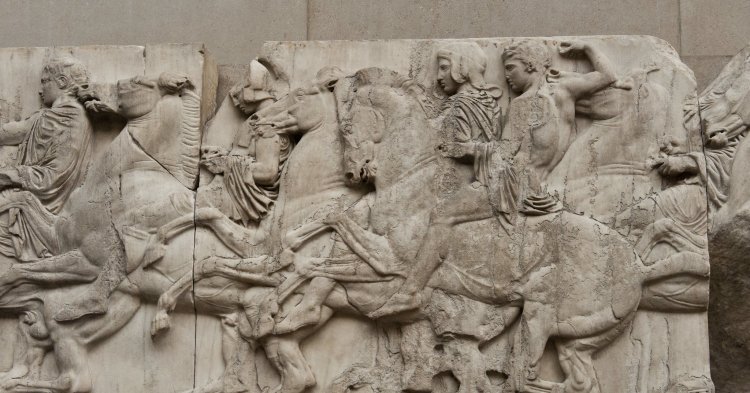In 2018, the Sarr-Savoye report requested by Emmanuel Macron built up the framework for the returning of cultural goods to African countries that were previously colonised by France. However, debates and polemics are still abundant: is cultural heritage national or universal? Aren’t artworks, more than cultural, political? Is this the opportunity to redefine European history through culture and exchange?
Returning, restituting? The limits of the juridical framework
Words have their importance: should artworks be returned, restituted or repatriated to concerned countries? According to UNESCO, “return” includes “cultural objects that have been lost following a colonial or foreign occupation”, meaning cultural objects that return to their country of origin after having been stolen by a State. “Restitution”, on the other hand, applies to cultural objects that have disappeared following an illicit appropriation and includes those artworks that stayed in their countries of origin after having been stolen.
The case of the portrait of Adele Bloch-Bauer is an emblematic example of cultural restitution. Painted by Klimt in 1907, the painting was stolen during World War II by the Nazi Regime. In 2006, at the end of a long juridical battle, it was given back to the niece of the owner – and then sold for 135 million dollars to a New York billionaire. Here is an example of a restitution to a private citizen. Is it, however, this simple for States?
The concept of restitution is highly debated. After its first usage in 1973 by the UN General Assembly, it has been badly accepted by museums and owners of acquired artworks. Why? Because these notions refer to a shameful colonial era, that colonising countries refuse to condemn. Moreover, for museum curators, accepting this notion would be “opening Pandora’s box” and seeing their museums emptied of their collections. For Stéphane Martin, president of the Quai Branly museum in Paris, museums must not “be hostages of the painful history of colonialism”. Nevertheless, 70,000 African cultural objects are on show in the Quai Branly museum. In total, more than 90% of the major Sub-Saharan Africa artworks are outside the continent.
In the end, UNESCO takes the lead in the debate and states for the first time that cultural objects must be submitted to the law, due to their peculiar nature. An “Intergovernmental Committee for Promoting the Return of Cultural Property to its Countries of Origin or its Restitution in case of Illicit Appropriation” is created, gathering 24 elected member states such as Benin, Hungary, Egypt and Mali. The then Director General of UNESCO, Amadou-Mahtar M’Bow, gets down to business in order to restitute “at least the most representative treasures of their culture, those to which they attach more importance, those of which the absence is psychologically more intolerable”. UNESCO then defines the three essential components of the cultural object: the protection and security of restituted artworks, the supplying of artworks, and the transmission of objects.
Cultural heritage is certainly a vague reality, but it is founded on specific laws and geographical spaces. At what scale do we perceive cultural heritage? Depending on the space we focus on, our view on heritage changes. How to deal, then, with the case of stolen artworks? What about European cooperation? And about the relations between Europe and the rest of the world?
The sculptures of the Greek Parthenon at the British Museum: a common European heritage?
The example of the Parthenon marbles exposed at the British Museum is the perfect one: a struggle for the restitution of artworks that blends cultural arguments with political ones.
First of all, let us go back to the origins of the dispute. In the 5th century B.C., Athens was the most powerful city of the ancient Western world. The sacred hill of the Acropolis that dominates the city is where stands the Parthenon, the emblematic architectural masterpiece of Greek culture. The Parthenon, from Greek παρθενος (parthénos) that means “young girl”, was built by Pericles. This frieze illustrates the richness of Athens and wants to unite the citizens in a shared festival. It’s a frieze that celebrates the richness of the Greek heritage, often considered as the basis of Western civilisation, and that represents precious evidence for historians.
At the beginning of the 19th century, Lord Elgin, British Ambassador in Constantinople – as Greece was at the time under the rule of the Ottoman Empire – received a royal decree by the Great Vizir authorising him to do some sketches and castings of the Parthenon and its friezes. He overstepped this authorisation and stripped the building of its most beautiful marbles: in total, he had more than 200 blocks of marble removed, permanently damaging the building. In 1916, the British Parliament voted a law that grants the marbles in perpetuity to the British Museum. In the end, of the 97 slabs of the frieze, 56 are in England, while only 40 are in Greece.
The demand for the restitution of the marbles dates back to the independence of Greece, in 1832. In 1983, Greece, only just entered in the European Union, stated its will to have the marbles returned, thanks to the action of the then Minister of Culture, Melina Mercouri. Why hasn’t this demand succeeded yet? Because the long juridical dispute for the return of the marbles acts as the revealing symptom of the conflicts that surround cultural heritage: is it national, European, universal? And who is going to showcase them best?
So far, the British government has refused the request. The arguments are double: even if Lord Elgin had overstepped his rights, the UK states that the acquisition was made in full legal right. Moreover, in preserving the marbles, the UK applies the principle of universality of artworks stated by UNESCO. The other great Western museums align themselves with the British Museum, fearing that their own collections might follow this exodus. Is the argument that the UK would be the only one that can preserve the marbles really valid?
The debate has taken a new turn in the 21st century: in 2009, the new Acropolis museum was opened, located 300 metres below the Parthenon’s plateau. Since then, British arguments of preservation have no longer been valid, as the museum offers the required conditions of protection, preservation and security. In the museum, the absence of the marbles is flagrant: next to the originals, the eye of the onlooker is captured by some plaster replicas stamped “British Museum”.
Today, a new actor takes a stand in the debate of cultural restitution: public opinion. Thanks to the actions of personalities such as Nikos Aliagas (a French TV presenter), or the mobilisation of citizens through petitions, the return of the marbles is increasingly demanded both by the Greeks and the British.
Also, the return of Greek marbles not only covers an archaeological and historical issue, but also a cultural and political one. The question arises at a European level: the restitution would allow to showcase the idea of a European cultural heritage, besides sending a message of cohesion and unity of European countries among the identity and political crisis that Europe is facing today.
The return of African artworks: Europe facing its past, what cultural politics?
In November 2017, Emmanuel Macron visited the University of Ouagadougou in Burkina Faso, where he delivered a symbolic speech that marked a turning point in the relations between France and Africa: “Today we are orphans of a common imaginary: the African heritage cannot be hostage of European museums”. His strategy is clear: to establish a new narrative in the Franco-African relations, through symbolic gestures and strong acts. What if culture was the opportunity to reconcile memories?
“The genius of a population finds one of its most noble incarnations in cultural heritage, which constitutes, over the centuries, the work of its architects, its sculptors, its painters (...) Populations that have been victims of this sometimes centuries-old plundering have not only been stripped of irreplaceable masterpieces, they have also been robbed of a memory that would have, without any doubt, helped them know themselves better and certainly be better understood by others. (...) These cultural goods which are part of their being, the men and women of these countries have the right to recover them." (Amadou-Mahtar M’Bow, UNESCO Secretary General, 1978)
Culture is a fundamental issue: as much for the African continent as for the whole world. As behind this heritage, many identity, development and tourism issues are at stake. According to some experts, 85 to 90% of African heritage is outside the continent: how to build one’s own identity in these cases? Doesn’t the statement of the former French President Nicolas Sarkozy, according to whom “the African man did not make it into History”, reveal these inequalities of access to culture and to the building of self?
The Sarr-Savoy report, ordered by Emmanuel Macron in November 2018, marks a turning point in the crafting of, and the way States approach, their cultural and international politics. According to the report, restituting would come up to reinstituting the lawful owner of the cultural good. It calls not only for a readjustment, but also for justice and reparation. The report paves the way to new cultural relationships under reinvented ethics: “returning is offering a symbolic reparation of what has been degraded and establishing future relationships on a shared history”, according to Ms Savoy.
She adds: “it’s not about emptying French museums to fill in African museums”, as the will of the report’s authors is to point out that the youth of these countries doesn’t have access to a form of their memory. The decision of the French President to return 26 stolen artworks from Benin, exhibited at the Quai Branly museum - where one can find royal statues, thrones and other objects taken as a war prize at the end of the 19th century - is a historic decision that had international resonance. Despite the difficulty of applying the measures, this report marks a change of paradigm: the possibility for States to inverse the trend of cultural policies, which also modified the power relationships between States.
In the end, cultural heritage is a notion that goes beyond both national identities and the universal, both the cultural world and the political sphere. From the stolen marbles of the Parthenon to the African artworks of the Quai Branly museum, these artworks put our relationship with History and people’s cultures in perspective. If Europe became the leading actor in this fight, that would be an opportunity to found a new European cultural policy, based on exchange and ethics rather than the weight of past sufferings.


Follow the comments: |
|
